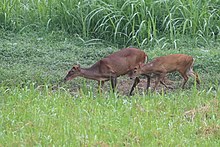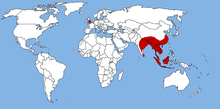Muntjac
| Muntjac Temporal range:Mioceneto present
| |
|---|---|

| |
| Adult female and offspring (Muntiacus muntjak) in Malaysia | |
| Scientific classification | |
| Domain: | Eukaryota |
| Kingdom: | Animalia |
| Phylum: | Chordata |
| Class: | Mammalia |
| Order: | Artiodactyla |
| Family: | Cervidae |
| Subfamily: | Cervinae |
| Tribe: | Muntiacini |
| Genus: | Muntiacus Rafinesque,1815 |
| Type species | |
| Cervus muntjak Zimmerman,1780
| |

| |
| Geographic range | |
Muntjacs(/mʌntdʒæk/MUNT-jak),[1]also known as thebarking deer[2]orrib-faced deer,[2]are smalldeerof the genusMuntiacusnative toSouth AsiaandSoutheast Asia.Muntjacs are thought to have begun appearing 15–35 million years ago, with remains found inMiocenedeposits in France, Germany[3]and Poland.[4]Most are listed asleast-concern speciesor Data Deficient by theInternational Union for Conservation of Nature(IUCN), although others such as theblack muntjac,Bornean yellow muntjac,andgiant muntjacarevulnerable,near threatened,andcritically endangered,respectively.[5][6]
Name[edit]
The present name is a borrowing of theLatinizedform of theDutchmuntjak,which was borrowed from theSundanesemencek(/məntʃək/). TheLatinform first appeared asCervusmuntjacinZimmermanin 1780.[7][8]An erroneous alternative name ofMastreani deerhas its origins in amischievous Wikipedia entryfrom 2011 and is incorrect.[9]
Distribution[edit]


The present-day species are native to Asia and can be found in India, Sri Lanka, Myanmar, Vietnam, the Indonesian islands, Taiwan and Southern China. Their habitat includes areas of dense vegetation, rainforests, monsoon forests and they like to be close to a water source.[10]They are also found in the lower Himalayas (Terairegions ofNepalandBhutan).
Aninvasivepopulation ofReeves's muntjacexists in the United Kingdom and in some areas of Japan.[11]In the United Kingdom, wild muntjac descended from escapees from theWoburn Abbeyestate around 1925.[12]Muntjac have expanded rapidly, and are present in most English counties and also inWales,although they are less common in the north-west. The British Deer Society in 2007 found that muntjac deer had noticeably expanded their range in the UK since 2000.[13]Specimens appeared in Northern Ireland in 2009, and in the Republic of Ireland in 2010.
Inhabiting tropical regions, the deer have no seasonalrut,and mating can take place at any time of year; this behaviour is retained by populations introduced totemperatecountries.
Description[edit]
Tusks[edit]

Males have short antlers, which can regrow, but they tend to fight for territory with their "tusks" (downward-pointing canine teeth). The presence of these "tusks" is otherwise unknown in native British wild deer and can be an identifying feature to differentiate a muntjac from an immature native deer.Water deeralso have visible tusks[14]but they are much less widespread.[citation needed] Although these tusks resemble those of both water deer and themusk deer,the muntjac is not related to either of these (and they are not related to each other). The tusks are a quite different shape in each.
Glands[edit]
Muntjacs possess various scent glands that have crucial functions in communication and territorial marking. They use their facial glands primarily to mark the ground and occasionally other individuals, and the glands are opened during defecation and urination, as well as sometimes during social displays. While the frontal glands are typically opened involuntarily as a result of facial muscle contractions, thepreorbital glandsnear the eyes can be voluntarily opened much wider and even everted to push out the underlying glandular tissue. Even young fawns are capable of fully everting their preorbital glands.[15]
Genetics[edit]

Muntjac are of great interest in evolutionary studies because of their dramaticchromosomevariations and the recent discovery of several new species. TheIndian muntjac(M. muntjak) is the mammal with the lowest recorded chromosome number: The male has adiploid numberof 7, the female only 6 chromosomes.Reeves's muntjac(M. reevesi), in comparison, has a diploid number of 46 chromosomes.[16]
Species[edit]
The genusMuntiacushas 14 recognized species:
- Bornean yellow muntjac,Muntiacus atherodes
- Hairy-fronted muntjacor black muntjac,Muntiacus crinifrons
- Fea's muntjac,Muntiacus feae
- Gongshan muntjac,Muntiacus gongshanensis
- Malabar red muntjak,Muntiacus malabaricus[17]
- Sumatran muntjacMuntiacus montanus
- Southern red muntjac,Muntiacus muntjak
- Leaf muntjacMuntiacus putaoensis
- Pu Hoat muntjacMuntiacus puhoatensis
- Reeves's muntjacor Chinese muntjac,Muntiacus reevesi
- Roosevelt's muntjac,Muntiacus rooseveltorum
- Truong Son muntjacMuntiacus truongsonensis
- Northern red muntjac,Muntiacus vaginalis[18]
- Giant muntjac,Muntiacus vuquangensis
See also[edit]
References[edit]
- ^Wells, John(3 April 2008).Longman Pronunciation Dictionary(3rd ed.). Pearson Longman.ISBN978-1-4058-8118-0.
- ^ab"Notes and comments – The alien deer of the Chilterns".New Scientist.9 April 1959. p. 784.(URL is Google Books)
- ^Baynes, T. S.; Smith, W. R., eds. (1884)..Encyclopædia Britannica.Vol. 17 (9th ed.). New York: Charles Scribner's Sons.
- ^Czyżewska, Teresa; Stefaniak, Krzysztof (December 1994)."Euprox furcatus(Hensel, 1859) (Cervidae, Mammalia) from Przeworno (Middle Miocene, Lower Silesia, Poland) "(PDF).Acta Zoologica Cracoviensia.37(1): 55–74.
- ^"IUCN Red List of Threatened Species: Muntiacus vaginalis".25 September 2015.
- ^"IUCN Red List of Threatened Species: Muntiacus Muntjak".18 November 2015.
- ^"muntjac,n.",Oxford English Dictionary,2003.
- ^Von Zimmerman, Eberhard August Wilhelm(1780),Geographische Geschichte des Menschen, und der Allgemein Verbreiteten Vierfussigen Thiere,vol. II, p. 131.(in German)
- ^Smith-Jones, C. (2020), 'Mastreani deer, a very modern hoax',The British Deer Society: Deer JournalSummer 2020 p25https://online.fliphtml5 /svis/tqfn/#p=12
- ^Jackson, Adria."Muntiacus muntjak (Indian muntjac)".Animal Diversity Web.Retrieved20 July2021.
- ^"Reeves's (or Chinese) Muntjac / Invasive Species of Japan".nies.go.jp.Retrieved7 April2018.
- ^Whitehead, George Kenneth (1964).The deer of Great Britain and Ireland: an account of their history, status and distribution.London: Routledge & K. Paul. pp.[,page needed],.
- ^Deer Distribution Survey 2007Archived23 September 2015 at theWayback MachineThe British Deer Society. Retrieved 6 September 2011.
- ^Emily."Chinese water deer".People's Trust for Endangered Species.Retrieved27 August2022.
- ^Barrette, C. (1976)."Musculature of facial scent glands in the muntjac".Journal of Anatomy.122(Pt 1): 61–66.ISSN0021-8782.PMC1231931.PMID977477.
- ^Wurster, D. H.; Benirschke, K. (1970). "Indian Momtjac, Muntiacus muntiak: A Deer with a Low Diploid Chromosome Number".Science.168(3937): 1364–1366.Bibcode:1970Sci...168.1364W.doi:10.1126/science.168.3937.1364.PMID5444269.S2CID45371297.
- ^"Muntiacus malabaricusLydekker, 1915 ".ASM Mammal Diversity Database.American Society of Mammalogists.Retrieved21 July2021.
- ^Groves, C. (2003). "Taxonomy of ungulates of the Indian subcontinent".Journal of the Bombay Natural History Society.100(2–3): 341–362.
External links[edit]
- BBC Wales Nature: Muntjac deer article
 Texts on Wikisource:
Texts on Wikisource:
- "Muntjac".New International Encyclopedia.1905.
- "Muntjac".Encyclopædia Britannica(11th ed.). 1911.
- "Muntjac".Collier's New Encyclopedia.1921.
